|
Interview with a Dreamer |

|
Interview with Kristofer J.
"Harley" Harlson
- Lynnwood, Washington - USA |
Harley Harlson
is going to sail his 8 foot "Sea Biscuit"
around the world. Solo. Non-stop. It’s now
been a a few weeks since Harley's article, Impossible
Dream, and his Photo
Album were published in Duckworks Magazine.
As expected, readers have had a lot of questions
to ask. "Sea Biscuit" is being prepared
for her sojourn so he has not had much time to answer.
With that in mind, we offer the interview below:
We are both proud
and excited to announce that we will be posting
daily position maps of Harley's route throughout
his voyage and hopefully some messages as well.
CLICK HERE
Duckworks
Magazine (DWM): There has been quite a response to
your article, ‘Impossible
Dream’, and also to your construction photos
in the ‘Impossible
Dream Album’. They seem to range all the
way from disbelief to mild hero worship! Any general
feelings about the response?
 Harley:
Actually, I’m quite pleased with the response.
Something like this will always generate a wide spectrum
of replies because it makes people think. It forces
them to put themselves in my place, and that I believe,
is why the reaction can be sometimes quite emotional.
It is difficult though, to truly imagine oneself confined
to a coffin-sized space for a period exceeding a year’s
duration. It is natural that some regard the task
with disbelief, and others with awe. I have long contemplated
this endeavor and spent hour upon hour in that small
space already having built and prepared Sea Biscuit
for her journey. To me it feels quite natural. Harley:
Actually, I’m quite pleased with the response.
Something like this will always generate a wide spectrum
of replies because it makes people think. It forces
them to put themselves in my place, and that I believe,
is why the reaction can be sometimes quite emotional.
It is difficult though, to truly imagine oneself confined
to a coffin-sized space for a period exceeding a year’s
duration. It is natural that some regard the task
with disbelief, and others with awe. I have long contemplated
this endeavor and spent hour upon hour in that small
space already having built and prepared Sea Biscuit
for her journey. To me it feels quite natural.
DWM:
We understand that you have prepared in secrecy for
some time in order to avoid the kind of problems with
the Coast Guard that Hugo Vihlen encountered. Has
there been any exposure prior to your article at Duckworks
Magazine?
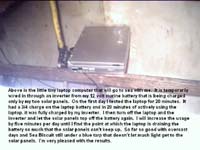 Harley:
Very minimal but yes, there was an article in ‘The
Spray”, a publication of the Joshua Slocum Society
International, my earliest supporters and contributors.
At that time I was going to leave in June of 2005.
I delayed the voyage for an employer, who had needed
my computer hardware expertise. I worked for them
full-time for a year and a half, and that delayed
progress on Sea Biscuit. The article in ‘The
Spray” went out only to the few hundred members
of the Joshua Slocum Society however, so I wasn’t
too worried about the exposure. Harley:
Very minimal but yes, there was an article in ‘The
Spray”, a publication of the Joshua Slocum Society
International, my earliest supporters and contributors.
At that time I was going to leave in June of 2005.
I delayed the voyage for an employer, who had needed
my computer hardware expertise. I worked for them
full-time for a year and a half, and that delayed
progress on Sea Biscuit. The article in ‘The
Spray” went out only to the few hundred members
of the Joshua Slocum Society however, so I wasn’t
too worried about the exposure.
DWM:
Many small boat voyagers such as Tom McClean and Billy
Dunlop mentioned difficulty with their boats inability
to sail close to the wind. Sea Biscuit’s shape
seems a little more traditional. Do you anticipate
the same sort of problem?
Harley: I don’t
really, though sea trials will reveal her characteristics
and may even affect my calculations as to the duration
of the voyage, and the exact route I will take. I’ve
done quite a bit of experimentation with hull shapes
in boats of twelve feet and under, and I expect that
Sea Biscuit is going to surprise everyone with her
windward abilities.
DWM:
We understand you’ve received some criticism
from folks about your “MacGyverism” in
choices of materials and construction techniques;
the use of scrap woods, galvanized steel mesh stuck
to the inside of the hull, etc. Someone even suggested
that you abandon Sea Biscuit altogether and rebuild
with more conventional techniques. How would you answer
that criticism?
 Harley:
I think that people simply don’t understand
boats like ‘Sea Biscuit’, Gerry Spiess’
‘Yankee Girl’, many of Tom McNally’s
boats, Hugo Vihlen’s ‘April
Fool’ and ‘Father’s
Day’ and others. These boats are
designed for a specific task. They’re designed
to be incredibly tough initially to last the duration
of their voyages, but not to last for thirty years
like a traditional boat. I have slapped Sea Biscuits
hull with a sixteen-ounce hammer many times to demonstrate
how strong she is to skeptics. It is my rather innovative
and unusual techniques that make her so. At the end
of my voyage, ‘Sea Biscuit’ will be pulled
from the water and will probably never touch it again.
She’ll travel around with me to speaking engagements
for a few months and will probably end up in a museum.
She’ll last the voyage without any problems
and that’s all that I require. If I were to
rebuild for some strange reason, I can't think of
a thing I would change. Harley:
I think that people simply don’t understand
boats like ‘Sea Biscuit’, Gerry Spiess’
‘Yankee Girl’, many of Tom McNally’s
boats, Hugo Vihlen’s ‘April
Fool’ and ‘Father’s
Day’ and others. These boats are
designed for a specific task. They’re designed
to be incredibly tough initially to last the duration
of their voyages, but not to last for thirty years
like a traditional boat. I have slapped Sea Biscuits
hull with a sixteen-ounce hammer many times to demonstrate
how strong she is to skeptics. It is my rather innovative
and unusual techniques that make her so. At the end
of my voyage, ‘Sea Biscuit’ will be pulled
from the water and will probably never touch it again.
She’ll travel around with me to speaking engagements
for a few months and will probably end up in a museum.
She’ll last the voyage without any problems
and that’s all that I require. If I were to
rebuild for some strange reason, I can't think of
a thing I would change.
DWM:
We’ve noticed that unlike most of the small
boats we’ve seen make long ocean passages, Sea
Biscuit’s hatch is located a little further
forward of the transom. We think this makes a lot
of sense because every ocean-going boat gets pooped
once in a while and with a boat as tiny as Sea Biscuit,
such an occurrence could mean the end of the line,
or at least create an awful mess below.
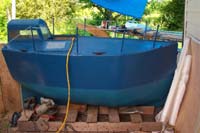 Harley:
Yeah, I think that the transom-located hatch is just
a carry-over from the traditional sailboat that has
an aft cockpit. I never understood why so many of
the small ocean voyagers I’ve seen continued
with the tradition. It just didn’t make sense
for Sea Biscuits mission. Harley:
Yeah, I think that the transom-located hatch is just
a carry-over from the traditional sailboat that has
an aft cockpit. I never understood why so many of
the small ocean voyagers I’ve seen continued
with the tradition. It just didn’t make sense
for Sea Biscuits mission.
DWM:
We sometimes feel like little kids urging their buddy
to do something dangerous - something we would never
do ourselves - something that could be disastrous
- with no regard for our friend's well being.
Harley: To all
those who feel that they have been encouraging me
and maybe they shouldn’t be… I have been
planning this journey some four years now with nothing
but negative energy from most people. I’d be
doing this with or without the kind words that I’ve
been showered with since making my plans public to
the boating community. I am solely responsible for
putting myself to sea in this tiny boat. It’s
one of the reasons I shall not bring an EPIRB with
me on the voyage, or long distance radio. I do not
wish for anyone to risk his or her lives trying to
save me from my own folly. I have every reason to
believe that I will successfully complete this journey,
but should something unfortunate happen to me I blame
no one but myself. Neither should you.
DWM:
Okay. Now tell us, how can you possibly put enough
food into an eight-foot boat, particularly one with
the dimensions of Sea Biscuit, to make it around the
world without re-supplying her?
Harley: Ah,
the most-asked question. Most don’t like my
answer, and everyone seems to have other ideas about
what I should bring. I’ll start by saying that
those who know the least about the requirements of
the human body generally call themselves ‘Nutritionists”.
I have lived on various diets successfully all of
my life, spent 8 years as a vegetarian, and I’ve
come to disregard just about everything those guys
say. Let’s face it, nine-tenths of the known
population of the world live on rice with a handful
of herbs or insects or whatever thrown in. It’s
not rocket science. That being said, here’s
what I’m bringing.
A years supply of some food tablets
with me that are supposed to be enough to live on
all by themselves. I am also bringing survival foods
designed for use in lifeboats, which are also supposed
to be enough to survive on all by themselves. This
I will supplement with a plankton net which when I'm
in the right areas will allow a very nourishing tablespoon
of really yucky, hard to swallow goosh, a combination
of both plant and animal life that is incredibly nourishing.
I am also bringing a single-burner propane stove for
very occasional use. A 25-lb. bag of Basmati rice.
Some flour for making hard tack (the traditional "Sea
Biscuit" made simply of flour and seawater.)
which I have developed into a technique, using a Norwegian
Krumkake Iron, which allows me to make a thin 6-inch
wide cracker in about 60 seconds. Throw in some legumes
for making fresh sprouts as Sir Francis Chichester
did, 400 single serving tubs of peanut butter that
can fill in any unused space in my storage, a tablespoon
of oil added to the preceding adds 500 calories daily
to my diet. I am also bringing dried meats, and dried
fruits. I have very carefully measured the nutritional
value versus the bulk of all my foods and found that
I can, but not so easily, carry enough to last me
a year. The combination of this diet and my also innovative
food-rationing scheme, that of rationing by distance
traveled rather than by time, ensure my success.
DWM:
Explain that; your “food-rationing scheme”.
Harley: Here’s
how it works. Let’s plan on having enough food
for 400 days. Take my distance around, say 27,500
miles and divide by four hundred. That means I’m
going to allot a day’s worth of food to travel
about 69 miles. If it takes me two days to travel
69 miles, I go on half-rations. Not a big deal, because
when I move into the next 69-mile segment of my voyage,
I get to recalculate. If I’m able to supplement
my diet with fish or other some other unfortunate
creature, I get to save some of my stores for future
use. By using this scheme, I am able to make it around
with out ever running out of food.
DWM:
What about mental and emotional needs? Many would
think you could easily go mad out there all alone
in that tiny space for a year or more.
Harley: I’ll
do what all long distance voyagers do. I’ll
talk to myself.
DWM:
What about those who say that is the very definition
of madness?
Harley: It’s
apparently not. Many psychologists have studied this
phenomenon, and found that it is a way to actually
save ones sanity. Gerry Spiess, who sailed his ten-foot
‘Yankee Girl’ across the Atlantic and
then the Pacific, has even suggested that sailors
establish a "relationship" with their imaginary
companion before departing to lessen the probability
that the imagined person will be someone who is antagonistic
or overly critical! Makes sense to me.
DWM:
What about entertainment?
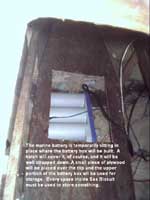 Harley:
I’m bringing a fipple flute, a harmonica, a
Grundig AM/FM/Short-wave radio that has it’s
own clockwork generator, a small library of miniature
books, a DVD player, my laptop, sketchpads, ships
log, and of course I’ll be writing some of my
book about the journey while at sea. I may even bring
a guitar that I cut down to fit in Sea Biscuit along.
I’m also going to have email through my InMarSat
transceiver so I can have at least some contact with
the outside world that is two-way. I’m also
bringing a hand-held five-watt VHF Marine band radio
so I can converse with ships along the way and beg
them to not run me over. Harley:
I’m bringing a fipple flute, a harmonica, a
Grundig AM/FM/Short-wave radio that has it’s
own clockwork generator, a small library of miniature
books, a DVD player, my laptop, sketchpads, ships
log, and of course I’ll be writing some of my
book about the journey while at sea. I may even bring
a guitar that I cut down to fit in Sea Biscuit along.
I’m also going to have email through my InMarSat
transceiver so I can have at least some contact with
the outside world that is two-way. I’m also
bringing a hand-held five-watt VHF Marine band radio
so I can converse with ships along the way and beg
them to not run me over.
DWM:
How will you navigate?
Harley: My InMarSat
transceiver provides me with my position, as well
as weather data for the area I’m in, speed,
bearing, etc. I am carrying a hand-held GPS unit,
and an additional GPS for backup. I’ll also
carry my sextant and it’s attendant manual,
mostly for fun but of course as a last-ditch backup
for navigation. I’m bringing few charts, mostly
two, each of which cover half the globe. I’ll
mainly track my course on graph paper for fine detail
and then transfer the data to my world charts. Of
course I have pilot charts to view also, and charts
of the major fish and bird migration patterns and
wind and ocean currents. There’s really not
much more room in Sea Biscuit for anything else.
DWM:
What about the Sea Trials, a shakedown cruise? What
are your plans there? We understand that Sea Biscuit
is still being prepared for the journey.
Harley: Sea Biscuit
will be fully loaded with all her supplies for a float
test on a local lake. All of her stores will then
be moved around until she floats on her lines. I’ll
then take her for a sail on the lake. From there she
moves to salt water. I’ll sail her on Desolation
Sound near my home and see how she reacts to larger
waves and stronger winds. From there, she goes to
the ocean off the Washington Coast where I’ll
spend a week to ten days offshore testing storm tactics
and various sail settings and her self-steering rigs.
After that, we go on our voyage.
DWM:
That doesn’t really sound adequate to us. I’m
sure many of our readers would agree. How do you answer
those charges?
Harley: I don’t.
Look, there have been plenty of people who have set
sail with a whole lot less experience than I. Tanya
Aebi set sail without knowing how to navigate. Chay
Blythe set off to race around the world without even
knowing how to sail! Young Jesse Martin only had his
boat in the water for a week before setting off on
his voyage with only three hours of solo sailing experience
under his belt. I have spent countless hours sailing
alone, I already have offshore experience and I have
designed, built, and sailed all of my own boats. I
really only need enough experience with Sea Biscuit
to know that she performs as I had anticipated. That’s
enough as far as I’m concerned.
DWM:
Muscle atrophy is a real problem on long voyages,
even for those on much larger boats. How will you
get enough exercise while at sea?
Harley: I have
given that a lot of thought, of course. I believe
that pumping my desalinators for an hour each day
will provide adequate upper body exercise. I have
an arrangement of elastic and two handles to provide
a little back exercise, and for my legs I have a bicycle-type
device installed in Sea Biscuit to keep my legs from
atrophy. In addition I will employ isometric techniques
and when the seas permit, I’ll be able to stand
up in the hatch and make sure that all the muscles
associated with balance are being taken care of. I
expect I may be in better shape upon my return than
I am now.
DWM:
It doesn’t look like you’ll be steering
with a tiller. How does your steering work? What type
of self-steering are you using?
Harley: Sea Biscuit
is steered by rope from the inside. Her sails are
handled from inside as well. I have a trim-tab type
vane gear to steer the boat while on a reach and when
going upwind. Sea Biscuit steers herself with the
sails flying wing-in-wing with the sheets connected
through a series of blocks directly to the rudder
when on a downwind tack.
DWM:
Tell us more about your rig. How does that work?
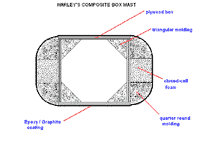 Harley:
Sea Biscuit has twin masts at the transom that meet
in a gentle arc at the top. A set of roller-furled
twin staysails connects from masthead to the bow.
The two sails lay against each other and act like
a single sail most of the time but spread apart to
go wing-in-wing the rest of the time. Her masts are
hollow and contain my ventilation system as well as
a copper braid connecting a lightning rod at the masthead
to a copper plate mounted on her keel. A vane-directed
scoop at the masthead directs air down through one
mast where it follows a duct to the bow. Air flows
through the boat and is collected at the base of the
other mast where it flows up to a point about eleven
feet off the deck and is vented out. At the head of
each mast there is a snorkel-like device that closes
off the airflow and of course waterflow, should Sea
Biscuit be knocked down or inverted. In addition,
there are valves inside the boat at the base of each
mast that allow me to shut off the airflow (or waterflow!)
altogether if I so choose. Harley:
Sea Biscuit has twin masts at the transom that meet
in a gentle arc at the top. A set of roller-furled
twin staysails connects from masthead to the bow.
The two sails lay against each other and act like
a single sail most of the time but spread apart to
go wing-in-wing the rest of the time. Her masts are
hollow and contain my ventilation system as well as
a copper braid connecting a lightning rod at the masthead
to a copper plate mounted on her keel. A vane-directed
scoop at the masthead directs air down through one
mast where it follows a duct to the bow. Air flows
through the boat and is collected at the base of the
other mast where it flows up to a point about eleven
feet off the deck and is vented out. At the head of
each mast there is a snorkel-like device that closes
off the airflow and of course waterflow, should Sea
Biscuit be knocked down or inverted. In addition,
there are valves inside the boat at the base of each
mast that allow me to shut off the airflow (or waterflow!)
altogether if I so choose.
DWM:
Why did you paint Sea Biscuit blue? Some have suggested
a bright orange color would make her more visible,
and easier for ships to spot you, and also easier
for a rescue vessel to spot you.
Harley: I like
blue. I was also trying to court a potential sponsor
at one time whose logo is on a blue background. Ships
won’t be likely to see me whatever the color;
it’s really going to be my job to watch out
for them. I shall be self-rescuing in any case and
won’t be calling for help. I put myself out
there, I shall rescue myself or I shall die.
DWM:
Will you have any motor, or any other auxiliary form
of propulsion aboard Sea Biscuit?
Harley: I shall
have a yuloh aboard to waddle myself through calms
and out of the way of ships in a calm. I originally
thought about oars but couldn’t find an adequate
way to deploy them without putting more holes in Sea
Biscuits hull. I didn’t want any more openings
in her hull to let water in than she had already.
DWM:
How will sail control lines and steering lines go
through-hull without creating the same danger?
Harley: The steering
lines are attached inside the hull to a bicycle-type
housed cable that goes through-hull to attach to the
rudder. The sail lines will likewise go through a
piece of tubing that has an inside diameter equal
to the outside diameter of the line. In this way,
there will be little room for water to pass through.
DWM:
What kind of sea anchor or drogue will you be taking?
Harley: Technically,
none. I am bringing a standard Danforth, which will
be the only thing mounted on deck. It will be used
as a sea anchor by letting it lay deep with a very
long warp. This way I take advantage of the more stable
deep currents instead of the surface currents that
are moving in the same direction that I don’t
wish to go. If I need more drag the Danforth will
wear a shirt or other piece of clothing to create
more drag.
DWM:
How about lighting? Cabin lights? Navigation Lights?
Harley: A flashlight
held by Velcro to the ceiling supplies interior lighting.
It is a three LED light with it’s own Clockwork
generator. Navigation lights are not required on a
boat as small as Sea Biscuit. Should I wish to be
more visible to a ship I will shine a beam of light
onto the sail.
DWM:
What kind of hull repair kit and tools will you have
on board?
Harley: I have
a carefully chosen set of tools on board and a selection
of precut plywood and lumber for repairs as well as
underwater epoxy.
DWM:
What about medical supplies?
Harley: I’ll
have the usual first-aid supplies as well as suture
kits to sew myself back up if I’m injured and
also a plethora of vitamins, pain killers, antibiotics,
antidepressants, etc. I’ll just have to administer
medical care to myself. I can be in touch with my
doctor by e-mail should I need his assistance.
DWM:
Whether you use it daily or weekly you'll need gobs
of toilet paper, how much are you taking? Are you
simply using the ‘bucket and chuck it’
facilities?
Harley: Actually
I don’t have room for toilet paper. I’ll
be bringing flat packets of baby wipes, enough to
allot two per day. When that runs out it will have
to be a washcloth rinsed afterward in seawater to
freshen it. . For hygienic purposes I will keep my
hair short with a pair of scissors and shave daily
with disposable razors. I currently make one razor
last a month so I won’t need to bring but one
package. I shall not pollute the ocean with any plastic
or anything horrible like that but I will have to
dispose of bodily waste over the side. This will be
collected in a bottle for the obvious purpose and
solid waste will be deposited in a cut down bleach
bottle (bottom cut off) and then disposed of over
the side and rinsed clean. I’m afraid the baby
wipes will go over the side though, but they are fairly
biodegradable. Sponge baths will have to do most of
the time, though in the tropics I’ll be able
to take a swim. Sea Biscuit’s rudder has a step
on the bottom and a step cut into the side so I’ll
be able to reboard Sea Biscuit without too much trouble
at the stern.
DWM:
After further observation I'm interested in knowing
more about the structural robustness of the deck house.
For intense, the back plate only overlaps the transom
by a few inches and the front joints where Lexan meets
Lexan do not appear to be reinforced. Could you describe
the construction methods you used to fabricate this
section?
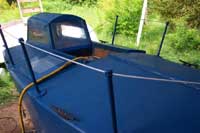 Harley:
The Plywood section at the back of the doghouse is
glued and screwed to the transom. The Lexan is glued
and screwed to the plywood, the wood frame, and to
itself. In addition, the two seams where the side
pieces meet the windshield are reinforced with aluminum
angle iron bonded and screwed to the Lexan, and the
bottom front edge of the Lexan windsheild is glued
and screwed to the two-by-four framework of the hatch
opening using a bracket of galvanized steel. It should
stay put. If it gets swept away by a rogue wave or
otherwise removed from the deck I will patch the gaping
hole and sail ala Charles Lindberg, without any forward
view unless I have my head poked through the hatch.
I have brought headgear and goggles designed to sail
this way should I need to. Harley:
The Plywood section at the back of the doghouse is
glued and screwed to the transom. The Lexan is glued
and screwed to the plywood, the wood frame, and to
itself. In addition, the two seams where the side
pieces meet the windshield are reinforced with aluminum
angle iron bonded and screwed to the Lexan, and the
bottom front edge of the Lexan windsheild is glued
and screwed to the two-by-four framework of the hatch
opening using a bracket of galvanized steel. It should
stay put. If it gets swept away by a rogue wave or
otherwise removed from the deck I will patch the gaping
hole and sail ala Charles Lindberg, without any forward
view unless I have my head poked through the hatch.
I have brought headgear and goggles designed to sail
this way should I need to.
DWM:
What camera equipment are you taking?
Harley: I’ll
be bringing a standard snapshot camera (film). I’ll
also bring a mini-camcorder that takes still shots,
and takes Avi’s for use in speaking engagements
later.
DWM:
Are you going to phase into your shipboard diet before
casting off? Starting out on a long-distance voyage
with food you have not been used to eating could spell
trouble. It would be like taking Sea Biscuit out on
the ocean without any sea trials, very risky.
Harley: I don't
want to eat this garbage any longer than I have to.
But I'm one of those guys with an iron gut. I've changed
my diet radically on many occasions without ill effect.
I'm just not worried about it.
DWM:
We have estimated that there is about 15 cubic feet
of foam inside Sea Biscuit which would provide about
870 to 900 pounds of lift. While this is a significant
amount for an eight-foot boat it is not overkill.
Do you think it is enough?
Harley: Like Gerry
Spiess, I shall use Sea Biscuits supplies as both
ballast and floatation. Containers will be refilled
with seawater to maintain Ballast and most of her
foodstuffs float. Containers will also have air left
in them for floatation as they are refilled.
DWM:
How high off the deck will the masts be? Sven Yrvind
recommends unusually short masts for his ocean going
smallboats. Short masts however mean slow going and
poor windward sailing. Hal Roth suggests a taller
rig because during his last circumnavigation he found
more light winds and calms than gales. He said he
was becalmed 11% of the time and most of his voyage
was in the Southern Ocean but that there were also
weeks of pleasant sailing in winds of 10-25 knots.
Higher rigs will pick up lighter winds when its calm
at sea level but we're talking 30 footers again and
not Sea Biscuit’s size.
Harley: The top
of Sea Biscuits mast is 12 feet off the deck with
the total mast height being 14 ft before they are
inserted in the boat. It's a so-so tall rig but I
also thought about light winds in the Pacific and
trying to beat my way home from the South.
DWM:
The two greatest maintenance fears for offshore sailors
are 1) having to climb to the top of the mast to retrieve
a fouled halyard and 2) having to go over the side
to clear an obstruction from the hull or rudder. How
would you address these two issues on Sea Biscuit?
Harley: I
knew when I designed Sea Biscuit that I'd never be
able to scale the mast because she'd just tip over!
So I designed her masts in such a way that I can just
yank them out and lay'em across the deck if I needed
to reach the top. If I drop the assembly overboard,
it floats, so I can just yank it back toward the boat
and haul it back up again. I'll make sure when I remove
the masts that the assembly is tethered to Sea Biscuit
so it can't get away from me. Sea Biscuit's rudder
can't be fouled easily because it sinks no lower than
the base of the keel. As far as freeing something
from the hull goes, I guess I'll just have to go overboard
but I should be able to unfoul the rudder from the
deck just leaning over the doghouse.
DWM:
Even though you will be sailing 90% of the time from
inside the cabin you need to have a safety harness
at the ready for those few times you may have to go
on deck or over the side during rough weather. Are
you taking a safety harness?
Harley: Yeah, I
don’t know if I'll actually have a full harness
as Gerry Spiess did (and that he wore almost continuously)
but certainly I'll tether myself to the boat at least
by tying a line around my waist "old school"
fashion when I go on deck.
DWM: We understand you are married. What
does your wife think about all this?
Harley: She first
forbid it, but slowly began to realize that the voyage
was inevitable, and finally, begrudgingly, lent her
approval. She eventually went so far as to take a
job to help me finance the voyage.
DWM:
Speaking of financing, you mentioned earlier that
you were at one time looking for a sponsor. Has anyone
else besides your wife contributed to the adventure?
Harley: My first
and only contributor was the Joshua Slocum Society
International who despite not really having funds
available for such things, being a very small non-profit
organization, sent me some money when I first told
them of my plans. My wife and I supplied the rest.
DWM:
One last question. Assuming this voyage is a success,
do you have any future plans?
Harley: Actually
I do. I plan to break Hugo Vihlen’s record for
the smallest boat across the Atlantic in 2008 in a
boat of my own design. (Or will it be Tom McNally’s
record by then?) I hope to have enough recognition
to then get enough sponsorship to go for Ellen MacArthur’s
record (or whoever’s record by that time) for
the fastest single-handed voyage around the world
in 2010, also in a boat of my own design, a large
catamaran.

|